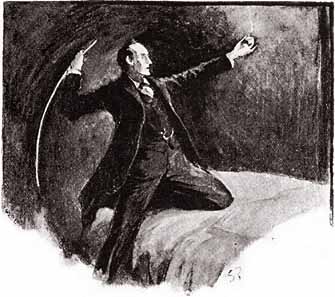A Scion Society of The Baker Street Irregulars

The 17 Steps: The Speckled Band
Seventeen thoughts for further ponderance of the case at hand – The Speckled Band (SPEC)

DR. ROYLOTT, MEDICINE MAN
Upon getting his medical degree, Grimesby Roylott seems to have immediately left the country to seek his fortune, going to Calcutta, where we are told “by his professional skill and his force of character, he established a large practice.”
We’ve heard of Englishmen leaving the country to go to war, to hunt for gold, to find a bride, but to establish a medical practice? Was there money to be made as a doctor in India? Or was this career direction a direct reflection of Roylott’s medical skills?
EIGHT YEARS WORKING ON HIS DETECTIVE DEGREE
Once again in SPEC, we get a reference to Watson as Holmes’s student, with mention of his notes and studying Holmes’s methods. But what was Watson’s goal in these studies? Did the doctor have hopes of becoming a detective himself, the first franchise of the Holmes consulting detective agency? Or might the doctor have had some other plan in his studies, other than the prose results that finally came of them?
HOW TERRIBLE CAN TERRIBLE BE?
Watson writes, “I have reasons to know that there are widespread rumours as to the death of Dr. Grimesby Roylott which tend to make the matter even more terrible than the truth.” What could be more terrible than a backfired attempt to kill one’s step-daughter with a deadly viper? Do these terrible rumors have anything to do with the death of that step-daughter, which apparently freed Watson from his promise of secrecy? Was the local gossip pointing fingers Violet’s way? And how would Watson know of rumors in Surrey?
THE DISPOSITION OF THE ANCESTRAL HOME
The Roylotts, one of the oldest Saxon families in England, held on to Stoke Moran right up to the last gasp of their boy Grimesby. But what then? Would the estate go to Grimesby’s step-daughter? And after her apparent death, what then? To her husband? Her child, if she died in childbirth?
GRIMESBY’S LOVE INTEREST?
Despite all the other odd parts of life with a bad-tempered step-father, the Stoner girls were allowed short visits to their mother’s maiden sister, Miss Honoria Westphail. Might this indicate a certain fondness on the part of Grimesby for his wife’s sister? It wouldn’t be the first occasion in those days, that a man took an interest in the sister of his late wife. And would this tend to show that Grimesby married Mrs. Stoner for love rather than money?
THE VANISHING HALF-PAY MAJOR
You’ve met a wonderful person. You become engaged. Two weeks before your wedding day, your lover drops dead of “fright.” What do you do? What can you do? Is it expected that Julia Stoner’s fiance should drop quietly off the map, or is this another crime we can lay at the feet of Grimesby Roylott?
HAND ME A MINT JULEP, GRIMESBY!
Though Stoke Moran is described as an old house and a few acres of land, we later get a reference to “those wretched gypsies in the plantation.” Is this use of the word the same as we’ve come to expect of the plantations of India or the Southern U.S.? Could one have a plantation on “a few acres”?
GATHER THE TORCHES AND STORM THE MANOR!
As if there weren’t enough horror overtones in this tale, we get echoes of Frankenstein in the words, “he has at this moment a cheetah and a baboon, which wander freely over his grounds and are feared by the villagers almost as much as their master.” Why would the locals tolerate free-roaming dangerous animals? Could Grimesby hope to keep a cheetah fenced in on a country estate? How long would it be before one of Grimesby’s monsters found a little girl picking flowers by a nearby pond?
HELEN STONER’S NOCTURNAL EMISSIONS
“I suppose that you could not possibly whistle, yourself, in your sleep?” Helen’s sister Julia asks her. Snoring, we know; talking in one’s sleep, most of us have run into; but sleep-whistling? Does such a thing exist?
NO WONDER THEY WENT TO HARROW FOR CHRISTMAS
Apparently that old Scrooge Grimesby didn’t want his girls to get visited by any man, even old St. Nick, as Julia’s “chimney is wide, but is barred up by four large staples.” How effective was this sort of chimney-barring and against what? Burglars, certainly, but would four staples in a wide chimney stop squirrels, birds, or other ordinary chimney pests?
A BIT MORE DAINTY THAN DARK GLASSES
We are treated to the nearly racey passage “Holmes pushed back the frill of black lace which fringed the hand that lay upon our visitor’s knee” just before we are shocked by the exposure of Roylott’s abuse. How would black lace fringe a lady’s hand in that period? From the sleeve or the gloves? A handkerchief up the sleeve perhaps?
HOW BIG WAS THE BIG GUY?
“So tall was he that his hat actually brushed the cross bar of the doorway . . .” we are told of Grimesby Roylott. Any estimates of the size of top hats and door cross bars, so that we can calculate the height of this brute?
THE RIGHT TOOLS FOR THE JOB
“An Eley’s No. 2 is an excellent argument with gentlemen who can twist steel pokers into knots. That and a tooth-brush are, I think, all that we need.”
Two questions: First, does the famous “Eley’s No. 2” have the stopping power to argue with a raging giant like good ol’ Grim? And second, Watson’s got a gun, Holmes has a toothbrush. What are the offensive capabilities of a toothbrush in the hands of a creative sort like Holmes?
HIS OWN INTERIOR DECORATOR
Behold the lair of the beast: “Dr. Grimesby Roylott’s chamber was larger than that of his stepdaughter, but was as plainly furnished. A camp-bed, a small wooden shelf full of books, mostly of a technical character, an armchair beside the bed, a plain wooden chair against the wall, a round table, and a large iron safe were the principal things which met the eye.”
What deductions can we make of Roylott from his room and its furnishings? What branch of technical was “technical”? Why the camp-bed for such a large fellow? Where did his wife sleep before her death?
HOW GOOD IS A BAD DOCTOR?
Holmes tells Watson, “When a doctor does go wrong he is the first of criminals. He has nerve and he has knowledge. Palmer and Pritchard were among the heads of their profession.” Is Holmes right? Were Palmer and Pritchard successful doctors, so much so they could be considered at the head of their profession? Are there any other examples in the history of crime of good doctors who were good criminals?
BUT WHAT ABOUT THE CAT WHIP AND THE MONKEY WHIP?
Holmes finds a “dog whip” in Roylott’s room. The modern reader might first think that this is an accessory for the ever-popular dog-cart, but is it really? Or is this an actual whip for use on man’s best friend, something fairly unthinkable in the modern era? Why single out dogs for the small whip, when hogs, goats, and other animals closer at hand than cart-to-horse range were equally controllable by the same size of whip?
ASSASSINATION SCHOOLS OF THE FAR EAST?
“The idea of using a form of poison which could not possibly be discovered by any chemical test was just such a one as would occur to a clever and ruthless man who had had an Eastern training.”
We know Roylott had experience in the East, but wasn’t his medical training all back in Britain? What training did he receive in India?
 The Seventeen Steps originally appeared on the Hounds of the Internet e-list from September 2000 to October 2001 and later on the Sherlock Peoria blog.
The Seventeen Steps originally appeared on the Hounds of the Internet e-list from September 2000 to October 2001 and later on the Sherlock Peoria blog.
Brad Keefauver, the 41st Garrideb, is the author of The Elementary Methods of Sherlock Holmes, Sherlock and the Ladies, and The Armchair Baskerville Tour. Former publisher of The Holmes & Watson Report, The Dangling Prussian, and a whole lot of obscure, collectable little things on our boy Sherlock. Keefauver is a member of the Baker Street Irregulars and the Adventuresses of Sherlock Holmes.

HOW GOOD IS A BAD DOCTOR? Here we may assume with some degree of certainty that Holmes wasn’t referring to Palmer and Pritchard as being among the heads of the medical profession but of the murder profession. William Palmer was hanged in 1856 and called in the press “The Prince of Poisoners” and was suspected in a half-dozen murders. Edward William Pritchard was hanged in 1865 for the poisonings of his wife and mother-in-law and suspected in others. Both gained notoriety in the press and became household names, leading Holmes to call them “the heads of their profession” with the profession being celebrity serial-killing-by-poison doctors. Of course, that’s a low bar to top, but one television Sherlock characterized serial killers as “onanists and mouth-breathers” and as we know from today’s media one does not need talent or skill to be a celebrity.